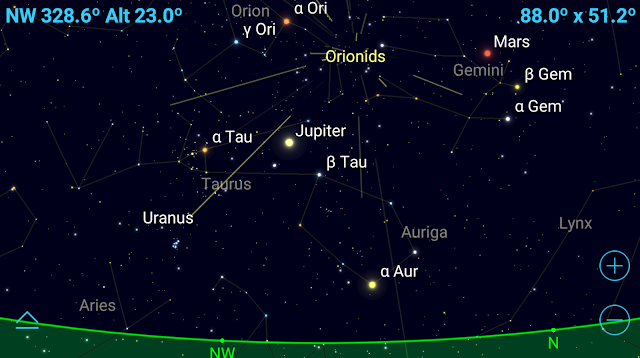Northern Hemisphere Meteor Showers
All images are from SkySafari 6 Pro
January: Quadrantids
The Quadrantids occur in early January and are known for their brief but intense meteor shower. Originating from the debris of asteroid 2003 EH1, they peak around January 3-4 annually. Named after an obsolete constellation, Quadrans Muralis, these meteors appear to radiate from the northern sky. With up to 100 meteors per hour under optimal conditions, the Quadrantids are often overlooked due to their timing during cold winter nights.
April: Lyrids
The Lyrid meteor shower, active from April 16 to 25, peaks around April 22. Resulting from the debris trail of Comet C/1861 G1 Thatcher, this shower is one of the oldest recorded, dating back over 2,600 years. Originating from the constellation Lyra, these meteors are visible in the northern hemisphere. With a rate of 10 to 15 meteors per hour, the Lyrids sometimes produce bright fireballs.
August: Perseids
The Perseids, arguably the most popular meteor shower, peak around August 11-13. Created by the debris of Comet Swift-Tuttle, they are observed annually between July 17 and August 24. Named after the constellation Perseus, these meteors are best viewed after midnight and can produce up to 100 meteors per hour. Their reliable and bright display makes them a favorite among stargazers.
October: Orionids
Active from October 2 to November 7, the Orionids peak around October 21-22. Originating from Halley's Comet, these meteors radiate from the constellation Orion. With a rate of around 20 meteors per hour, the Orionids are known for their speed and brightness. They are often visible even in areas with moderate light pollution.
November: Leonids
The Leonid meteor shower, originating from Comet 55P/Tempel-Tuttle, peaks around November 17-18. It's famous for periodic meteor storms, with the most notable occurring in 1833 and 1966. Although these storms are infrequent, producing thousands of meteors per hour, the typical Leonids display produces around 10 to 15 meteors per hour. They radiate from the constellation Leo.
Southern Hemisphere Meteor Showers
January: No Major Meteor Shower
April: Eta Aquariids
The Eta Aquariids, created by Halley's Comet, are visible from late April to mid-May, peaking around May 6. While more favorable to the northern hemisphere, southern observers can still witness around 10 to 20 meteors per hour. Originating from the constellation Aquarius, these meteors are known for their speed.
August: No Major Meteor Shower
October: Draconids (Minor Activity)
While more favorable for the northern hemisphere, the Draconids have minor activity visible in the southern hemisphere. Active from October 6-10, they peak around October 8. Originating from Comet 21P/Giacobini-Zinner, these meteors radiate from the constellation Draco.
November: Taurids
The Taurids, active from late October to late November, peak around November 5-12. These meteors, from Comet 2P/Encke, appear to radiate from the constellation Taurus. While not producing a high rate of meteors (around 5 per hour), they are known for producing bright fireballs.
Each meteor shower offers stargazers a unique celestial spectacle, encouraging enthusiasts to mark their calendars and find optimal viewing locations to witness these cosmic displays.







